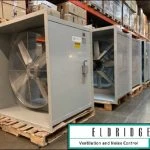 A dust collector is an air pollution control equipment used in industries, factories and other commercial settings. They help in meeting workplace and environmental safety requirements.
A dust collector is an air pollution control equipment used in industries, factories and other commercial settings. They help in meeting workplace and environmental safety requirements.
An effective dust collection system in industrial ventilation removes harmful particulates in the air produced during industrial operations. The system purifies and filters harmful dust and fine particulates released in the workplace and improves air quality.
Here’s more about the industrial dust collector and how it works.
How does a Dust Collector work?
A dust collector has a duct that draws in air, an air purifier and a receptacle. These basic elements are different for every type of dust collector.
- Duct collection ductwork- The ductwork design needs careful consideration to ensure proper system performance. The ductwork size changes throughout the collection system as it collects air drawn by the fans.
- Fans- When installing a fan in a dust collector, you need to consider the volume of air that needs moving. Also, you need to consider the static pressure through the system.
- Dust filter- The dust filter cleans the air in the dust collector. In other words, the blower pulls the air from the workplace into the filter, which then removes the particulates from the air.
- Receptacle- Once the particulate pass through the dust system and is removed from the filter, it falls into a receptacle for collection.
What are the Benefits of a Dust collector?
Today, many regulations and standards regarding air pollutants are rising; hence, dust collectors are becoming necessary. Besides the various regulations, there are other practical reasons for installing a dust collector.
- Improve Employee Morale
Employees who work in a conducive environment are more productive and have the morale to get through the day. A dust collector is essential in ensuring ideal working conditions; well lit and clean. Hence, every workplace should invest in a dust collection system.
- Respiratory Health
One of the main concerns for workers by regulators such as OSH and CDC is their safety in the workplace. Therefore, they have specific requirements regarding the allowable percentage of particles in the air. Violating these regulations will lead to business closure; hence the dust collector is essential.
- Reduction of Odor
Air in a dust collector is constantly circulating, helping to keep bad odours out. However, not all dust collectors can reduce odour, hence needing modification. When the odour is a concern in your workplace, use carbon-impregnated filters.
- Prevention of Explosion
Before the development of dust collectors, dust explosions, especially in woodwork shops, were common. Many woodwork shop owners build a wall that opens to the outside of their shop in readiness for any explosion. Dust collectors keep the air well circulated, thus preventing the possibility of dust collecting to produce an explosion bubble
- Fire Suppression
Where there is a concentration of dust and gas, it means there is a potential for fire. A dust collector, especially one with a spark arrestor, ensures that you can rest knowing that possibility of fire is minimal. In addition, since the dust collector is constantly moving, it prevents dust from collecting and being hazardous.
- Government Regulations
Compliance with government regulations is one of the motivating factors for installing a dust collector. Companies that do not adhere to the proper particulate percentage risk closure. OSH and NIOSH monitor do random inspections to ensure that they monitor harmful working conditions.
A dust collector helps remove particulate contaminants from the air in industrial complexes. With growing environmental concerns, dust collectors are now a vital part of industrial operations.
Having an efficient way to remove dust from the air is important for your employee health and well-being. Also, it keeps you in check with conforming to government regulations.
0


